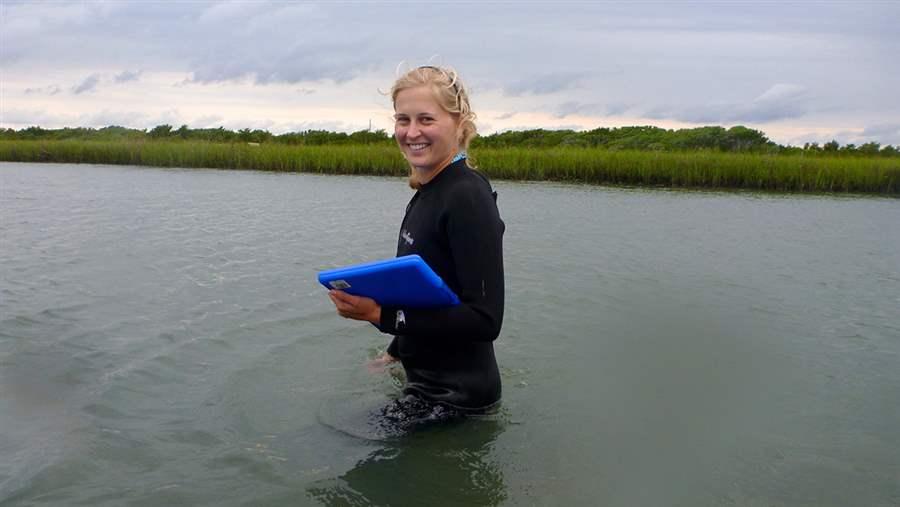'Living Shorelines Provide Better Habitat and Erosion Protection Than Bulkheads'
A Q&A with marine ecologist Rachel Gittman
 © Danielle Keller
© Danielle KellerNew research by marine ecologist Rachel Gittman finds that unmodified shorelines like this one in Beaufort, North Carolina, support more diverse species in higher populations than those hardened with structures such as seawalls and bulkheads.
Living shorelines foster greater biodiversity than seawalls, according to a recent Pew-supported research project. The study, conducted by Rachel Gittman, Ph.D., postdoctoral researcher at the Northeastern University Marine Science Center, looked at the effects of shoreline protection on coastal ecosystems. Specifically, she compared how many different species (i.e., biodiversity) and individuals of each species (i.e., abundance) were found on seawalls and bulkheads compared with living shorelines. Her article, “Ecological Consequences of Shoreline Hardening: A Meta-analysis,” was published in the journal BioScience.
We sat down with Gittman to learn more about her work and why it’s so important.
Q: What are shoreline protection structures, and why do people build them?
A: Shoreline protection structures include bulkheads and seawalls (vertical walls constructed parallel to shore at the high-water line, landward of intertidal habitats), riprap revetments (rock or rubble structures placed directly on the shoreline at or above the high-water line), and breakwaters and sills (rock, rubble, or oyster structures constructed parallel to shore, seaward of intertidal habitats). Breakwaters and sills are often paired with marsh plants, which are a type of “living shoreline.” Property owners build shore protection structures to prevent or slow erosion, which can impact nearshore property and infrastructure.
Q: What is a “living shoreline?”
A: People can mean different things when they refer to living shorelines, so it can be a bit confusing. It’s a broad term that can encompass everything from an unmodified or natural shoreline, to a restored shoreline with a combination of soft (e.g., native plants) and hard materials (e.g., rocks or oysters). NOAA describes a living shoreline project as one that “incorporates natural vegetation or other living, natural ‘soft elements’ alone or in combination with some type of harder shoreline structure, like oyster reefs, rock sills, or anchored large wood for added stability. Living shorelines connect the land and water to stabilize the shoreline, reduce erosion, and provide ecosystem services, like valuable habitat, that enhances coastal resilience.” The Pew-supported research focused on comparing the ecology of a shoreline that has not been modified with those that have.
Q: Where are living shoreline projects being used in the United States?
A: Living shoreline projects can be found along all of our coastlines, including the mid-Atlantic, Gulf Coast, and Pacific Coast. In particular, they have become increasingly popular on the North Carolina coast, along the shores of the Chesapeake Bay, and in the Puget Sound. My colleagues and I studied these types of living shorelines in North Carolina and found that they provide better habitat for juvenile fish and crustaceans and also performed better in terms of providing erosion protection during a Category 1 hurricane than shorelines with bulkheads.
Q: What did you find when you compared engineered structures with unmodified shorelines?
A: In completing our meta-analysis, we found a lower biodiversity and abundance of marine organisms along seawall and bulkhead shorelines than along unmodified shorelines. Essentially, there is a little over a 25 percent loss in biodiversity and also around a 35 to 40 percent loss in abundance when you have a seawall instead of an unmodified shoreline.
Q: Why is biodiversity of coastal species and abundance of individual organisms important?
A: Maintaining biodiversity can help maintain what are called “ecosystem functions and services.” For example, bivalves such as oysters and mussels filter nutrients and pollutants out of the water column, improving water quality, and small crustaceans and fishes serve as prey for larger commercially and recreationally valuable fishes. The more diverse and abundant organisms are in an ecosystem, the less likely human activities or natural disturbances are to result in a loss of ecosystem function or of entire species populations.
Q: Why do living shorelines support greater biodiversity and abundance?
A: Organisms are adapted to the range of environmental conditions found along their native, natural shorelines. When the shoreline is modified by a shore protection structure, those environmental conditions may change, and in some instances, may no longer be within the range suitable for some organisms.
Q: What is the significance of your research on this issue?
A: Our research provides further evidence that shoreline hardening, particularly the construction of seawalls and bulkheads, can have significant, adverse effects on coastal ecosystems.
Q: Based on what you learned, do you have recommendations for shoreline protection?
A: I would recommend that the ecological consequences of constructed shore protection structures be considered when deciding how to protect property and infrastructure found along shorelines. Living shorelines should be considered as a viable alternative to seawalls and bulkheads. With the right amount of education and incentives, it’s possible that we could persuade private property owners to think about the long-term sustainability, resilience, and ecological function of their shorelines rather than having a static, short-term view of shoreline protection.







